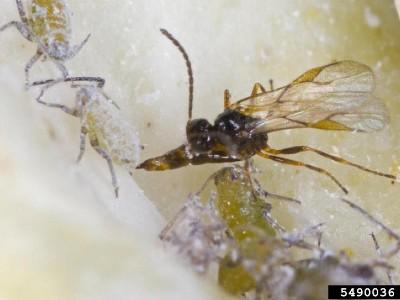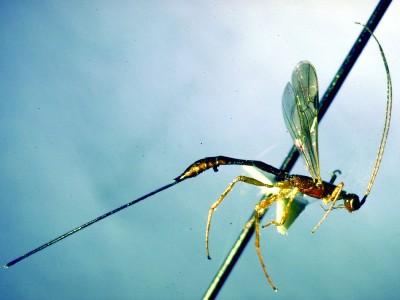
Braconid wasp (Spathius agrili). Photo: Jennifer Ayer, Bugwood.org
Braconid Wasps

Braconid wasp parasitizing cabbage aphids. Photo: David Cappaert, Bugwood.org

Hornworm larva covered with parasite cocoons. Photo: UM Extension
-
Braconid wasps are mostly internal parasitoids, but many emerge to pupate in silken cocoons attached to the outside of their hosts, or separate but close-by.
-
Perhaps the most widely recognized stage of any parasitoid wasp is the cluster of whitish/yellowish rice-like pupal cocoons of Cotesia spp. wasps (Braconids) found on tomato hornworms and cabbageworms.
Ichneumonoid wasps
-
Ichneumonoid wasps typically range from about 1/10” to 1 1/2” long, although one Ichneumon species (Megarhyssa) can be nearly 3” long including its very long tail-like ovipositor.
-
Ichneumons are slender, wasplike, with an abdomen longer than the head and thorax combined, and females frequently have an ovipositor (egg-laying organ) that is longer than their body.
-
Ichneumons vary greatly in size and color, from uniformly yellowish to black, or brightly colored with black/brown or black/yellow markings.
-
Braconids resemble ichneumons, but are usually smaller in size and darker in color, although some species have striking coloration.
-
Ichneumon wasps are the largest family of wasps, with thousands of species, and are common almost everywhere.
-
The dead hosts of many Ichneumon wasps shrink and become hard and brittle.
-
The normally greenish or white cocoons of larval hosts infested by some Ichneumon wasps may darken as the wasp develops within.

Ichneumonid wasp

Ichneumonoid wasp drilling through bark to reach wood-boring beetle grub